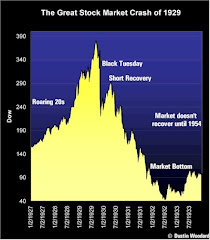
Heated discussions are flaring up over Regina's pension predicament.
There is concern and alarm over the huge shortfalls that taxpayers will have to fund. Taxpayers not only have the burden of covering the cost of their personal retirement shortfalls but in addition must pick up the cost of pensions for public sector employees.
Last year public sector employee pensions in Saskatchewan lost hundreds of millions of dollars.
A quick analysis at one of the smaller pension plans in Saskatchewan highlights some of the challenges ahead.
Saskatchewan Pension Page 32, 33
The Municipal Employees Pension Plan (in Millions)
2007 ........ $ 1,379 assets at year end
2008 est........ 260 lost in market collapse
2008 est........ 19 collected in Employee Contributions
2008 est........ 19 collected in Employer Contributions
2008 est ........64 in withdraws and transfers
Assets end of 2008 est. $ 1,093
2007 pension liabilities $ $1,223,958,000
My estimate leaves the plan short
$141,000,000 at the end of 2008.
Lets look at some of the numbers to see just how bad the situation is for this plan and the implications for its ability to pay future pension liabilities.
Employee and taxpayers contributions were $38 million. However, net withdraws from the plan were $64 million. This leaves the plan short $26 million. It is reasonable to expect that this can be made up by future investment earnings. ie. on the $1 Billion fund a return of only 2.6% is needed.
It becomes a little more challenging when we look at how to make up the existing shortfall of $141 million and also the fact that the plan's shortfall will likely continue each year at the same level or increase over the $26 million per year.
Now we need to make up an annual shortfall of at least $26 million, which over the next 5 years to $130 million, and the accumulated shortfall of $141,000,000.
Lets hope the markets take off!
Possible SolutionsIncrease Contributions We can see from this article that increased contributions are to be expected. However, these will come far short of what is needed. Several reports show that the current public sector needs annual contributions of 30% in order to be properly funded. The "high contribution rates" listed in the article of 18.8% (9.42% by the employee and employer) leave the pension still short almost 12%.
As taxpayers we need to ask why when we are already putting 9.42% of employee's salary into the public sector employee pension, do we need to also make up the shortfall?
Of course the usual argument for pensions bailouts by taxpayers, is that they are used as employee retention tools to attract workers. However this myth has been proven incorrect by the CFIB in their Wage Watch report that shows the huge gap in wages and benefits between the public sector and the private sector.
The Wage Watch shows Regina city workers ahead by 25% and Saskatchewan provincial workers ahead by 22.9% of workers in the private sector.
Other Pension Issues Retirees get big pay day!Not only are the pensions paid to the public sector unfair to taxpayers, many games are played to make them more valuable.
This article cites the huge vacation payouts made to retiring employees. The bonus comes from sick days not taken but paid out at retirement. They are accumulated each year. What is not fair is that the are accumulated in early years of employment at lower wages but paid out at the end at the terminating wage level.
In The City of Hamilton financial report the sick leave benefit payout is described as "Under the sick leave benefit plan of the City, unused sick leave can accumulate and employees may become entitled to a cash payment when they leave the City’s employment."
In Regina we saw one payout worth $429,406. Many public sector pension plans have built provisions to allow this to be used as part of the pension calculation.
How Spiking Works As the Canadian Federation of Taxpayers says... Taxpayers are in deep doo-dooo
What are these Pensions Worth?Here are links to information about the City of Regina pension
Regina Civic employees Plan Regina's Defined Benefit Plan Page 23 - Section 15
a) The annual pension payable shall be computed using, where applicable, the employee's average salary, his average base salary and his average excess salary. The employee's average salary shall be the average highest salary during any five (5) consecutive years of service completed prior to his retirement date.
Note:
The pensions is based on the best 5 years of service income.
It looks like those vacation payouts might be included as for pension purposes. Those vacation pay entitlements would add tens of thousands onto the annual pension income. Many would have pensions higher than their base pay. ie. those $400,000 payouts.
Page 25:
iii - (b) For service on and after July 1, 1958, two percent (2%) of his average salary for each year of service and any fraction thereof;
(c) Subject to subsection (vii)(g) herein the annual pension otherwise payable under this subsection shall not exceed the sum of seventy percent (70%) of the employee's average salary
Note: This bring the pension up to 70% of income or 2% per yer. Based on 35 years at 2% this is 70% of income.
Some jurisdictions in the states are coming out with pension disclosure like the Sunshine Act in Ontario.
Boston Pensioners List
What does this mean? Many Canadians will never be able to save enough to afford a comfortable retirement yet are forced to contribute into the pensions of the public sector. Most public sector employees will retire at a young age with gold-plated pensions far in excess of most Canadians' retirement savings. We cannot let this pension apartheid continue. CFIB states .... The unfairness has gone on long enough
As Pierlot has stated and also included in his report for the CD Howe Institute,
A Pension in Every Pot, the public sector workers retires with a pension in excess of $1 million. All this of course is funded by you.
Thanks you very much and get back to work, we need you to pay your taxes!!!






